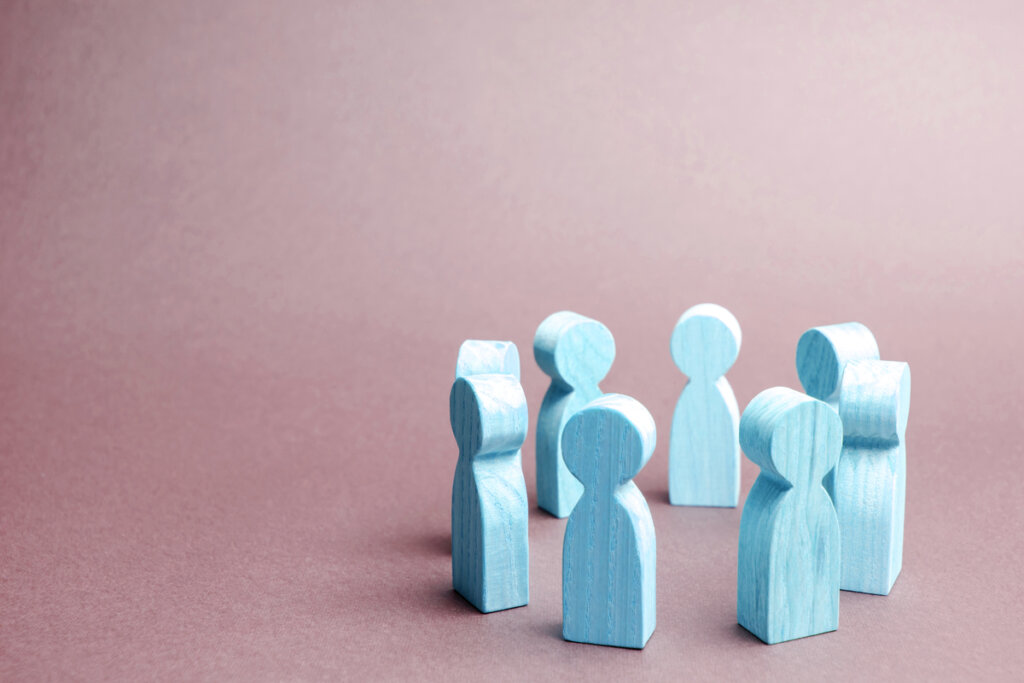The Differences Between Stereotypes and Gender Roles

Despite the great social advances made by the feminist movement and the sexual diversity movements, we still have a long way to go. It’s true that both stereotypes and gender roles have been changing and adjusting to the social demands of our time. Neverthless, we still need to make them visible and understand them. In this way, we can transform them.
However, what do we mean we talk about stereotypes and gender roles? How do they differ? In this article, we explain the differences between them. Furthermore, we identify some ways in which you can disassemble them in your everyday life.
Stereotypes
We can understand stereotypes as cognitive constructs built from characteristic attributes associated with a social group. In this way, stereotypes can be both positive and negative. They often serve to construct categories that organize information about the social world.
Stereotyping consists of making generalizations that simplify and group together ideas, beliefs, and imaginings about others. These simplifications, of course, are shared. In fact, to acquire their nature it’s necessary for them to circulate collectively and spread. Hence, they become codes understood by large groups of people.

Gender stereotypes
Taking into account the previous definition, gender stereotypes can be understood as culturally and historically social beliefs that are constructed in accordance with what a large part of society understands by being a man, a woman, or part of the LGBTIQ + community. In other words, they refer to the characteristics attributed to a group of people who identify with a specific gender.
Statements such as “women are more emotional than men” or “LGBTIQ + people are more outgoing than cisgender people” are gender stereotypes.
The problem with gender stereotypes is that they’ve become so naturalized that many times we don’t stop and think about the consequences they have. This is especially the case for women and sexual dissidents but can apply to men as well.
The existence of hyper-stereotyped imaginaries of masculinity or femininity makes those who don’t fit into this normative framework targets of criticism, judgment, and persecution.
Additionally, the reproduction of these stereotypes can keep us tied to gender roles. This greatly restricts both our possibilities for achievement as well as our capacity to fully explore our talents and capacities.
What’s a role?
We can understand the concept of role in two ways:
- On the one hand, from a sociological-anthropological perspective. Here, the idea of a role refers to the way in which a series of values, attitudes, and behaviors are culturally assigned to people. This is dependent on the place they occupy in a social structure.
- On the other hand, from a psychosocial perspective. From this view, a role is related to the way in which people act based on the expectations associated with a certain position.
In general, we can conceive of roles as organizational patterns of behavior. They’re loaded with expected behaviors and specific practices, and assigned to people based on their network of interactions and the position they occupy in the social world.
Gender roles
Working along the same lines, gender roles are all the ways in which gender stereotypes become behavioral expectations. These are pre-established and manifest in people as certain prescribed behaviors.
In other words, gender roles are the vehicle through which stereotypes are put into practice. For example, assuming that women should perform care tasks, or that men should be providers, or that LGBTIQ + people should be the life and soul of the party. It’s a form of naturalization of stereotypes associated with gender. A kind of naturalization that’s expressed through the expectation that people behave in predictable ways depending on their gender identity.

Is it possible to transform gender roles and stereotypes?
You probably now understand the difference between these two concepts. However, what can you do with this information?
Firstly, you should recognize that we’re all subscribed to gender norms even before we’re born. As a matter of fact, many of the ideas we have about what it’s like to be a man or a woman seem natural to us. Therefore, we tend to take them for granted.
For this reason, we need to begin to alter gender norms. To this end, we should ask ourselves questions about the socially constructed character of aesthetic opinions. We should consider our ways of relating, attitudes toward love and courtship, choice of professions, and children’s toys among many of the other dimensions that can be linked to certain gender norms.
Once we’ve done this, it’ll be easier for us to identify any gender roles and stereotypes in our own behaviors, and in the kind of conduct we expect from others. The transformation of these patterns depends on our own practices.
Despite the great social advances made by the feminist movement and the sexual diversity movements, we still have a long way to go. It’s true that both stereotypes and gender roles have been changing and adjusting to the social demands of our time. Neverthless, we still need to make them visible and understand them. In this way, we can transform them.
However, what do we mean we talk about stereotypes and gender roles? How do they differ? In this article, we explain the differences between them. Furthermore, we identify some ways in which you can disassemble them in your everyday life.
Stereotypes
We can understand stereotypes as cognitive constructs built from characteristic attributes associated with a social group. In this way, stereotypes can be both positive and negative. They often serve to construct categories that organize information about the social world.
Stereotyping consists of making generalizations that simplify and group together ideas, beliefs, and imaginings about others. These simplifications, of course, are shared. In fact, to acquire their nature it’s necessary for them to circulate collectively and spread. Hence, they become codes understood by large groups of people.

Gender stereotypes
Taking into account the previous definition, gender stereotypes can be understood as culturally and historically social beliefs that are constructed in accordance with what a large part of society understands by being a man, a woman, or part of the LGBTIQ + community. In other words, they refer to the characteristics attributed to a group of people who identify with a specific gender.
Statements such as “women are more emotional than men” or “LGBTIQ + people are more outgoing than cisgender people” are gender stereotypes.
The problem with gender stereotypes is that they’ve become so naturalized that many times we don’t stop and think about the consequences they have. This is especially the case for women and sexual dissidents but can apply to men as well.
The existence of hyper-stereotyped imaginaries of masculinity or femininity makes those who don’t fit into this normative framework targets of criticism, judgment, and persecution.
Additionally, the reproduction of these stereotypes can keep us tied to gender roles. This greatly restricts both our possibilities for achievement as well as our capacity to fully explore our talents and capacities.
What’s a role?
We can understand the concept of role in two ways:
- On the one hand, from a sociological-anthropological perspective. Here, the idea of a role refers to the way in which a series of values, attitudes, and behaviors are culturally assigned to people. This is dependent on the place they occupy in a social structure.
- On the other hand, from a psychosocial perspective. From this view, a role is related to the way in which people act based on the expectations associated with a certain position.
In general, we can conceive of roles as organizational patterns of behavior. They’re loaded with expected behaviors and specific practices, and assigned to people based on their network of interactions and the position they occupy in the social world.
Gender roles
Working along the same lines, gender roles are all the ways in which gender stereotypes become behavioral expectations. These are pre-established and manifest in people as certain prescribed behaviors.
In other words, gender roles are the vehicle through which stereotypes are put into practice. For example, assuming that women should perform care tasks, or that men should be providers, or that LGBTIQ + people should be the life and soul of the party. It’s a form of naturalization of stereotypes associated with gender. A kind of naturalization that’s expressed through the expectation that people behave in predictable ways depending on their gender identity.

Is it possible to transform gender roles and stereotypes?
You probably now understand the difference between these two concepts. However, what can you do with this information?
Firstly, you should recognize that we’re all subscribed to gender norms even before we’re born. As a matter of fact, many of the ideas we have about what it’s like to be a man or a woman seem natural to us. Therefore, we tend to take them for granted.
For this reason, we need to begin to alter gender norms. To this end, we should ask ourselves questions about the socially constructed character of aesthetic opinions. We should consider our ways of relating, attitudes toward love and courtship, choice of professions, and children’s toys among many of the other dimensions that can be linked to certain gender norms.
Once we’ve done this, it’ll be easier for us to identify any gender roles and stereotypes in our own behaviors, and in the kind of conduct we expect from others. The transformation of these patterns depends on our own practices.
All cited sources were thoroughly reviewed by our team to ensure their quality, reliability, currency, and validity. The bibliography of this article was considered reliable and of academic or scientific accuracy.
- D’Ovidio, Ana Clara (2020). Roles y estereotipos de género: experiencias de socialización en adolescentes. XII Congreso Internacional de Investigación y Práctica Profesional en Psicología. XXVII Jornadas de Investigación. XVI Encuentro de Investigadores en Psicología del MERCOSUR. II Encuentro de Investigación de Terapia Ocupacional. II Encuentro de Musicoterapia. Facultad de Psicología – Universidad de Buenos Aires, Buenos Aires. Disponible en: https://www.aacademica.org/000-007/16.pdf
- Velandia-Morales, A., & Rincón, J. C. (2014). Estereotipos y roles de género utilizados en la publicidad transmitida a través de la televisión. Universitas Psychologica, 13(2), 517-527. doi:10.11144/Javeriana.UPSY13-2.ergu
This text is provided for informational purposes only and does not replace consultation with a professional. If in doubt, consult your specialist.







